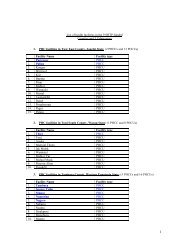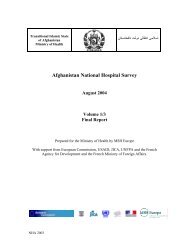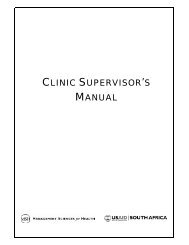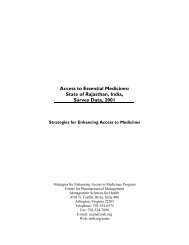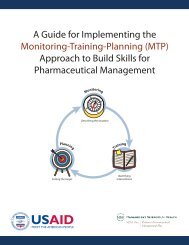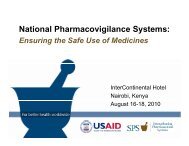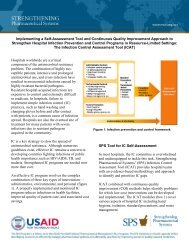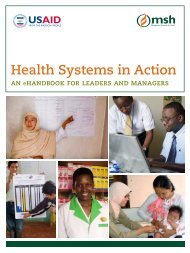Evaluation of Malawi's Emergency Human Resources Programme
Evaluation of Malawi's Emergency Human Resources Programme
Evaluation of Malawi's Emergency Human Resources Programme
You also want an ePaper? Increase the reach of your titles
YUMPU automatically turns print PDFs into web optimized ePapers that Google loves.
Management Sciences for Health<br />
Interventions proposed under Element 1 included salary top-ups and strategies for<br />
recruitment and retention. Through these components, numbers <strong>of</strong> health workers were<br />
expected to increase significantly by 2010. Individual targets were set on a yearly basis,<br />
by cadre, with an overall increase <strong>of</strong> 6,047 health workers in 2004 to 10,543 health<br />
workers in 2010, representing a targeted 74% overall increase (Annex A). 17 The staffing<br />
targets were established by senior <strong>of</strong>ficials in the MOH in collaboration with a consultant<br />
health economist.<br />
The eleven priority cadres <strong>of</strong> staff identified to receive the top-ups are: physicians, nurses<br />
(including midwives), clinical <strong>of</strong>ficers, medical assistants, laboratory technicians,<br />
radiography technicians, pharmacy technicians, dental therapists, physiotherapists,<br />
environmental health <strong>of</strong>ficers, and medical engineers. The 11 cadres were selected in<br />
discussion with the MOH, training schools and pr<strong>of</strong>essional associations. These cadres<br />
were perceived to be the most under stress and necessary to deliver the Essential Health<br />
Package and roll out HIV/AIDS-related services. 18<br />
Recruitment galas were planned to identify and recruit graduates from training<br />
institutions, as well as to re-engage health workers that had left the public sector for a<br />
variety <strong>of</strong> reasons. In addition, a hardship package was proposed, in which health workers<br />
would receive additional incentives for accepting posts in remote hardship areas.<br />
The purpose <strong>of</strong> Element 2 was to significantly increase the number <strong>of</strong> Malawian health<br />
workers in training, and to improve capacity at the major training institutions. This was to<br />
be accomplished by paying for student tuition fees at the institutions, and providing<br />
money for infrastructure development to allow for increased student capacity. The training<br />
institutions were expected to increase graduate output by 50%, including doubling the<br />
number <strong>of</strong> doctors and tripling the number <strong>of</strong> nurses and clinical <strong>of</strong>ficers. This general<br />
target was refined with a training costing model that detailed outputs by cadre, taking into<br />
consideration the current and projected capacity <strong>of</strong> the major training institutions (Annex<br />
B). 19 The model projected an increase in graduates from 842 in 2004 to 1,534 in 2010,<br />
representing an 82% increase. The four main training institutions are Malawi College <strong>of</strong><br />
Health Sciences (MCHS), Kamuzu College <strong>of</strong> Nursing (KCN), College <strong>of</strong> Medicine<br />
(COM), and the CHAM institutes.<br />
No specific targets were set for the number <strong>of</strong> volunteers for Element 3 in the EHRP<br />
design documents, although an approximate number <strong>of</strong> 90-100 was suggested. 20 The<br />
volunteers were suggested as a stop-gap measure, to fill emergency gaps while more<br />
Malawian doctors were being trained under Element 2; therefore, this element <strong>of</strong> the<br />
EHRP was not planned to be sustained indefinitely.<br />
17<br />
Martin-Staple, Anne. Six-Year <strong>Human</strong> Resource Relief <strong>Programme</strong>: Revisions and Year-One<br />
Implementation Plan. Short-term consultancy report, December 2004.<br />
18<br />
Source: Debbie Palmer, personal communication, May 26, 2010<br />
19<br />
Martin-Staple, Anne. Proposed 6-Year <strong>Human</strong> Resource Relief <strong>Programme</strong> for the Malawi Health Sector,<br />
Part II: Training and Tutor Incentive. June 2004.<br />
20<br />
Presentation by Matt Gordon, “Malawi’s <strong>Emergency</strong> <strong>Human</strong> <strong>Resources</strong> <strong>Programme</strong>: An Overview” made<br />
to DFID, 5 November 2008.<br />
EHRP <strong>Evaluation</strong> Final Report Page 11



